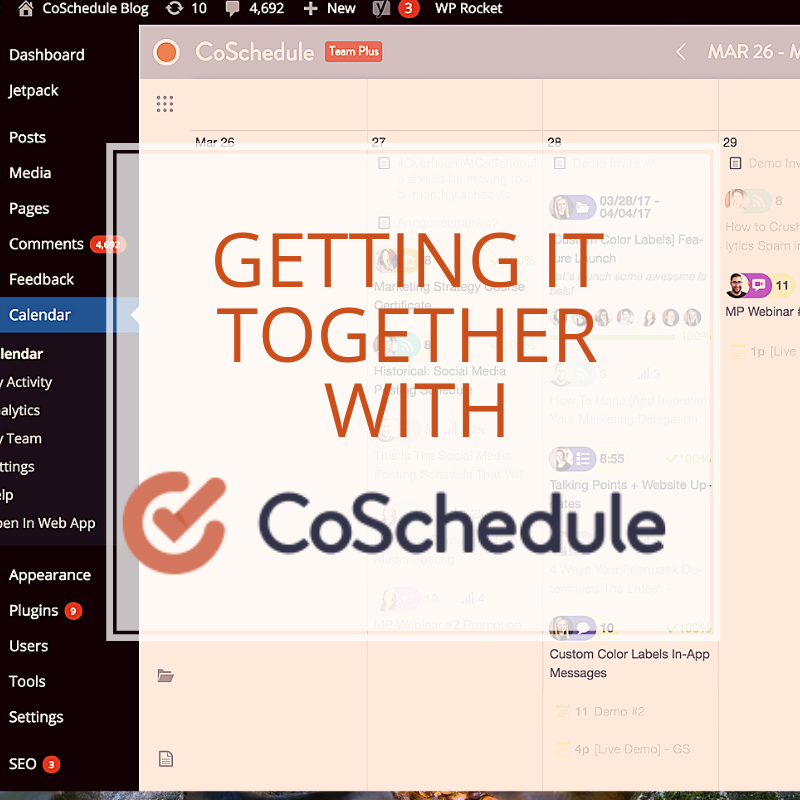
My first sponsored post – I am writing this review to reduce my subscription to a marketing tool that has the promise of helping me get it together to get the word out about my work (books, workshops and practice) with a bit more aplomb. If you follow the links in this post and decide to try coschedule too, I’ll get a little discount to my subscription.
Slow but sure. So far so good.
The Promise
The promise of Coschedule is that all my communication will be integrated – my monthly newsletter, weekly blog, and daily social activity will all be singing like a choir in tune. So that people – my people – my online tribe – will gather around my excellent teaching and together we will change this world. Influencers will gather about me, oohing and aahing. The perfect brands will also gather – the brands my readers may actually want, begging me to somehow get them in front of my readers.
Current State of Affairs
OK, phew. I used Coschedule for about a month before I took a pause to polish up an approaching retreat. In that time, things got started – not quite as quickly as I’d wished, but I did move forward. There was a bit of education as to how to think. Now, I have a MS in Communication and do have a marketing mindset, but this was different – thinking in terms of everything I do in terms of a campaign, or defining into some other communications thing, was a little next-level for me. I know I need to go there – it’s the natural next step for my blog and teaching. But, like life itself, it’s a process.
I’m excited by the possibilities of Coschedule, and can see the outline of how it works. Much of the learning within the app is geared toward team communication, and at this writing I am a solo entrepreneur looking to this app to be a certain type of automated assistant. As I begin to work with more organizations this may change and I guess it’s good to know that the app can expand as I grow, but right now, finding just the support that helps me fast-track what I am looking for is…not yet found. Taking a little more time and focus than I’d hoped. But, I’m back from my international travel and ready to dive in again.
So, I am going to try it – at this writing, I am thinking I’ll experiment with it for a year. But, it’s got to make me feel better (and save me time and mind-space) within a couple months of giving it a good try. I’ll measure my success in how well I reach new people who resonate with my work, how much my list grows, books sell, private practice fills, and how well my (under development) courses grow. Got it? I am going to watch and adjust and aim to grow. Hoping Coschedule helps me – and helps you.
Want to check it out? If you use this link, I will get a small discount on my subscription.
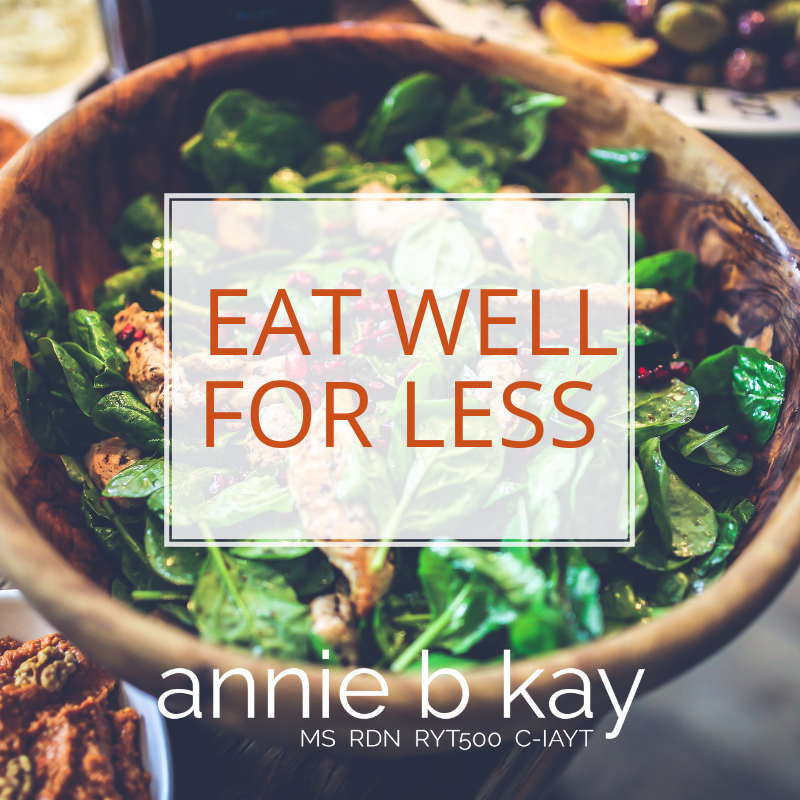
Quality food and produce – organics, artisanal, delicious – is more widely available than ever before. Yet when I check out from my whole foods grocery – especially when I’m preparing for a special holiday or family dinner, I imagine my father (a rural farmer cash-on-the-barrel sort of guy) fainting dead away at the grand total. Yipes! The price of high-quality (like organic grass-fed) meat or dairy, and fresh produce can take your breath away. You can eat well for less.
It takes some time and effort, but once you get into the swing of the practice, it’s just how you do it. The nutrition and taste benefits are very worth the effort.
If you feel the desire to eat high-quality food, but you aren’t independently wealthy, here are 7 ideas to help you eat well on a budget:
1. Try mindful eating.
Many Americans simply eat too much – be it healthy food or not. But just how much is enough? We’re designed to know. Mindful eating can help you find out how much food fills you up and gives you energy throughout the day. In fact, mindful eating is a practice that can help you turn down the external messages about what and how much to eat, and to tune in more deeply to your internal guidance system.
You can experiment by becoming a little more aware of the portion sizes you eat, and use mindful eating to help you experiment with just how much is enough. It’s a real sweet spot – adequate without over nor under-doing eating. It’s a practice for sure, and we humans by nature seem to over- or under-do it. So, if you struggle with this, you are not alone! Be patient and keep practicing.
How about an experiment – quality over quantity?
Begin by experimenting with mindfully eating various foods – from treats like designer chips, whole foods take-out, gourmet pizzas and stevia sweetened sodas to more healthful choices like fresh vegetables and fruit, beans, nuts and whole grains. See how different foods make you feel, and how much seems to be enough to satisfy and give you energy through the day (I know, easier said than done). Eating lightly (and for some, passing on snacking) can be both healthful and cost-effective. The practice of mindful eating is a great place to begin to explore just what eating lightly means for you.
2. Enjoy plants.
If you have more than one serving of animal protein each day, you may be healthier and more frugal to look to plant-based protein to replace some of the meat and dairy you’re eating. Need some ideas on a delicious way to focus on plant fare? Check out my recipe page, and my friend The Veggie Queen, who dedicates her working life to helping you enjoy more plants easily.
3. Consider a CSA or community food CO-OP.
Cut out the middleman and ensure the freshest local produce makes it into your kitchen all season long through a direct relationship with a local farm. To get stared check out Local Harvest. They will tell you how to get into the mindset, prepare to join, and help find your nearest community-supported agriculture (CSA) farms and CO-OPs.
4. The bulk food aisle (or discount website) is your friend.
Get a break on nuts, spices, whole grains and just about everything beyond fresh produce. If you don’t live near a grocery store that offers bulk staples, of course the internet marketplace is there wherever you are. The Spruce has a good article on their favorite online grocery sites.
5. Browse your market’s circular.
If you are so inclined to browse your supermarket’s circular, you really can shave a lot off your weekly food costs. My husband (astonishingly) does this as a practice – he plans our shopping around the meat and seafood that is on sale – and he is truly amazing at it. The deals he gets are phenomenal! You do have to be aware that items on sale might not be the most healthful, so you need to practice discretion here.
6. Organic online coupons? Yep.
Check out All Natural Savings – a gal dedicated to online couponing – to get you started. Whole Foods also has a weekly deals and sales page. So many ways to use them to eat well for less.
7. Keep it all in perspective.
There’s a certain new math – a longer-term economics we need to consider when we think about the higher cost of clean whole food. That new equation is hidden beneath cheap subsidized corn, sugar, meat and dairy. As a nutritionist for the past 25 years I know that this cheaper refined food is responsible for a world of disease and pain. In my practice I see people improve their health every day through committing to higher quality nutrient-dense, low chemical load food. Most people feel better right away when they move away from the standard American diet and learn to make small choices toward health while enjoying what they eat and feeling great regardless of the number of the scale. The benefits continue to build over time with longer, healthier lives.
When it comes to quality food, no one can eat perfectly all the time unless they have limitless income, their own farm and a small team of vegetable choppers at the ready.
So, do what you can to eat well for less, and let the rest go. Small changes can add up, over time, to transformation.
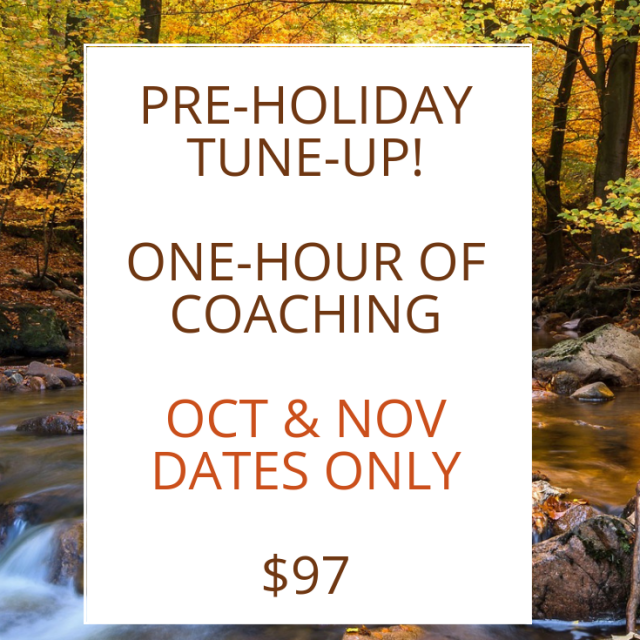
Something about the time between Halloween and New Years – it’s both the most challenging nutritional time of the year, and the time of year when, well, dietitians might just go on vacation. We know you’ll be looking for us come New Year’s!
That’s why I am offering a quick tune-up coaching special for October and November. During these months, you can have a session with me either by phone or zoom. It’s 22% off the usual cost for a 60-minute session with me.
Here’s a step-by-step of your Coaching Tune-up
Before the session, you’ll fill out some quick intake information to help us both think about how the holidays unfold for you and how you’d like them to unfold from a health perspective. You’ll book your appointment and off we go.
During our coaching session, we’ll review your intention, co-create a high-impact doable strategy, brainstorm how to overcome barriers, and talk about how to think about this in a way that will help you build on your practice, strengths and success in the new year.
You can also continue the conversation with follow-up sessions – but the idea is one session, buff you up. Boom.
Sound good? Sign up now.
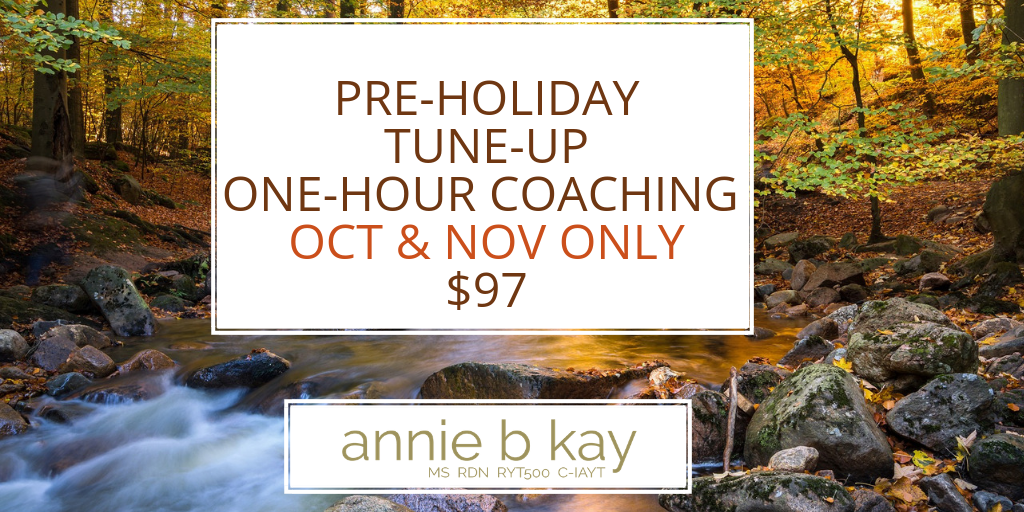

Hey friends,
I’m thrilled to be involved in an online summer for women in the wisdom years. For me, moving into the second half of life is a serious blend of satisfaction, and well, a little confusion – what’s next?
Here’s the information on it.
The Shift Network’s Thriving in Your Third Act: Women Finding Fire & Fulfillment After 50
You’ve lived a rich life, filled with knowledge, experiences, and accomplishments… and you may now be asking yourself, “What’s next?”
Maybe you find yourself thinking, “I’ve loved my career, my family, but I want to spend the rest of my life doing _____________ (fill in the blank)…”
If so, don’t miss this opportunity to join bold leaders who are on fire with possibility and purpose — including Jean Shinoda Bolen, Dr. Judith Orloff, Dr. Joan Borysenko, me, Anodea Judith, Yeye Luisah Teish, Grandmother Flordemayo, Cynthia James, Katie Hendricks, Rev. Deborah Johnson, Camille Maurine, Sarah Marshank, and others. Women who will guide you with their hard-earned wisdom and support your personal journey of transformation.

During this unparalleled 5-day gathering, you’ll discover:
- How to be a “juicy crone” & discover the Goddesses and Archetypes that are active in the postmenopausal phase of your live
- Practices for worry-proofing yourself & avoiding the midlife “happiness dip” by retraining your brain
- The role of stress as the most critical (yet unrecognized) nutrition issue of our time
- Explore how to harvest the charge in your energy body and bring more life force into your tissues
- Exciting possibilities for reinventing your life, your focus, & your passions
- Key practices to help you renew your life and reinvent yourself — free of cultural myths — and bask in the great joy of presence, connection, & new forms of play
- How to create a supportive, thriving community of your choice
- How to maintain optimal health during your wisdom years
- How to express yourself spiritually as you become an Elder
- Practices for igniting the power of your empathy and intuition to revitalize every area of your life
- Step into the fullest expression of yourself as you journey to a new adventure in your 50s and beyond
- Embody your inner boldness, expand your capacities in standing for Love
Join us for Thriving in Your Third Act, August 20-24.
RSVP at no charge here.
If you download the summit to listen to later, I will receive a modest referral fee. Last year I listened to it for months! So much wisdom!
Yours truly,
Annie
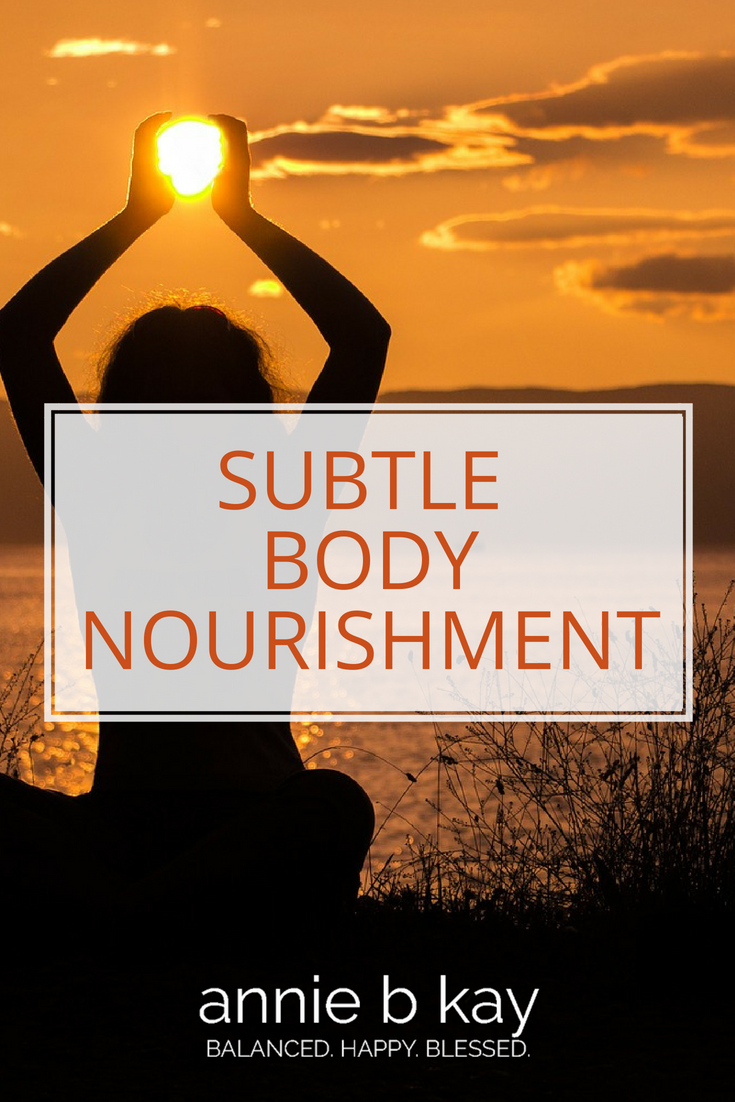
Getting the balance of eating and yoga practice down is a challenge for anyone. We overdo it, we under-do it, we practice when we’re full. We under-eat and don’t have the energy to perform. Sigh. Our energy, as well as our hunger peaks and valleys – getting it right is a dynamic dance.
Understanding and experiencing your own subtle body (in yoga, that includes your thoughts, intuition and energy bodies) takes practice. When you practice skillful navigation of your subtle body, particularly balanced with the knowledge of your nutritional needs, it can help prevent you from falling off a nutritional cliff of over- or under- doing it. This is especially handy once you begin the esoteric energy practices and learn that you have greater control over hunger and satiety that you’d realized. Then, having the wisdom of science to anchor you in adequacy is even more important to maintaining physical health.
That’s subtle body nourishment.
Why Bother? Benefits of Energy Practice
When you learn eating meditation techniques you are learning how to turn inward and participate in your body’s guidance systems – you have the option of taking more control – be it breath or eating or even thinking. That’s what all the hoopla is about. If we don’t understand that we are taking the steering wheel of hunger and satiety, it’s easy to under-eat once prana (life force, or energy as in your breath) starts expanding and getting excited. Then, it’s easy to overeat through your inevitable energy contraction.
Many a yogini seems to get into eating trouble when learning these more esoteric practices. It doesn’t have to be that way.
Life is an energy experience. Meditative practices are energy practices, and require that you spend time within your inner landscape – the more time you spend there exploring and curious, the better you will know and be able to navigate that landscape.
By learning how to operate your own subtle body, you can ultimately better navigate the chaos without getting overwhelmed by static. You can operate in a more intentional way.
This sort of practice brings consciousness to your personal energy ecology; the conditions under which you shine, for example.
Energy practice, meditation, mindfulness can help you learn how to improve your digestion – how to basically give your bodies what it needs (time and calm, primarily) to digest properly.
What is the Subtle Body?
In yoga philosophy, the subtle body is the aspect of you that is unseen by the human eye. It includes your thoughts and emotions, the wisdom aspect of you – your intuition, and your energy body.
The subtle body profoundly determines how you feel, react and respond to the world around us. When you learn how to guide your own thoughts, for example, you can literally change your perception of your own life. When you learn to ground your energy body, you can handle the spiral of chaos that the world at times seems to be, rooting in the real rather than swirling away in yet another frenzied tweet.
Food & Yoga Practice
The truth of the matter is that everyone is different – physically but also nutritionally. How well you can perform right after you eat, and the ideal makeup of a meal to fuel your practice is individual. There are, however, guidelines – rules of the road. Ayurveda practitioners say that certain foods create certain energies. Western science has their own version of the same idea – in a very different language. The language of macro and micro nutrition, and meal timing.
Ultimately, the way to figure out what works for you is to do the experiment. Notice how it works for you.
I’ve been thinking about subtle body nourishment and how food and practice interact in preparation for a gathering of souls at Kripalu July 8-11, Sunday through Wednesday morning. If these topics get interest you, consider joining me to practice, explore and learn about what the yogis and Western nutrition has to say about it.
Be well, practice on.
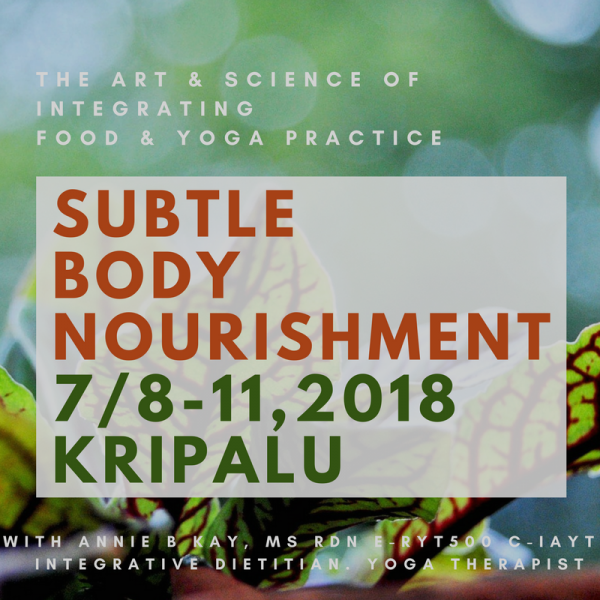
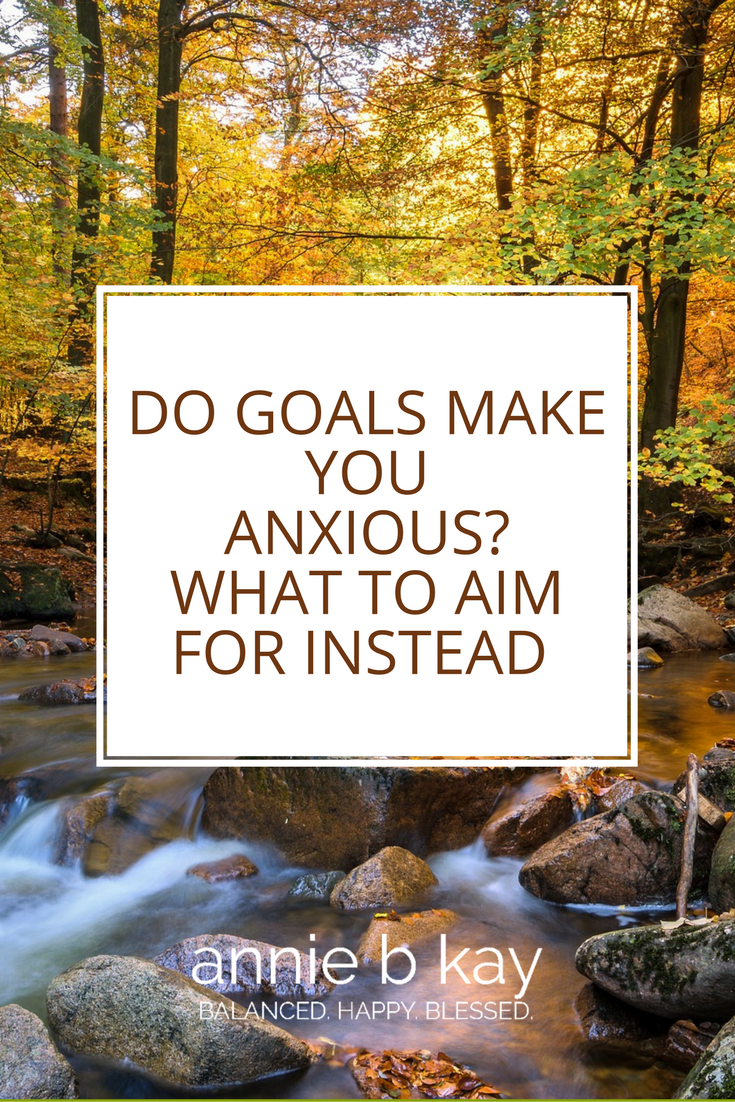
I’ve always be a goal-oriented gal. Every year-end I love to reflect on the year that was, integrate the lessons and vision what may be.
I’ve noticed, however, when working with people who are trying to change, that setting goals can trigger anxiety. Goals don’t always seem to support happy change, and we can get a little reductive and crazy around them – push push push. Goals also suggest an endpoint.
When it comes to lifestyle change, there isn’t an endpoint – there are ongoing choices and adjustments. There is practice. Rather than goals, how about milestones – points along the way that can let you know you are on the road you intend. Rather than push, how about flow.
Words are important – they do nothing less than create our world. So, let’s re-think the language surrounding goals – particularly if goals make you anxious.
Rather than goals, think about shift (I call them milestones). Rather than relapse, it’s life (I bow down to my teacher-friend Aruni for that one!). This language feels more real and relevant. When I use allowing and flow language in a workshop, I can see people relax and focus on what really matters – bringing their lives a bit more in alignment with who they are.
The yogis say that change is a dance of being and becoming. Of embodiment and right action. Here in the West, we focus so much on the action phase, but really not at all on the quieter embodiment side of practice. Of walking your talk, and acting as if you understood how sacred the process can be.
Today, life is moving so fast, and is so open to limitless possibilities and is so unpredictable that setting goals seems…not so relevant. I like the idea of getting clear what you are interested in bringing into your life, and the practice doing that – experimenting with the many ways you can walk your talk, and take the right next step.
Did you make goals for 2018? Have they made you a little anxious? How about giving yourself a break, and softening your goal language into shifts, milestones, and practice?
Here are a some other articles on supporting shift and intentions for this new year.
Intention in Action – New Year’s Intentions
Intentions Can Last – Here’s How
Gather Ye Guides











